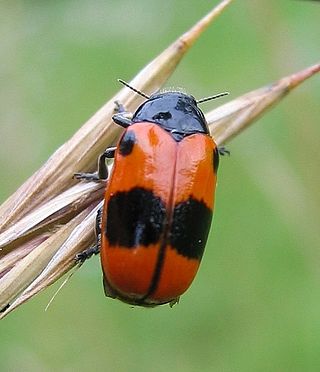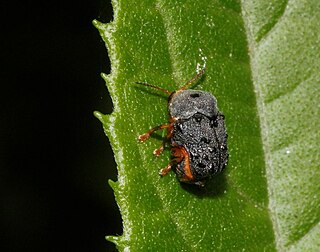
Pierre Henri Marie Schaeffer was a French composer, writer, broadcaster, engineer, musicologist, acoustician and founder of Groupe de Recherche de Musique Concrète (GRMC). His innovative work in both the sciences—particularly communications and acoustics—and the various arts of music, literature and radio presentation after the end of World War II, as well as his anti-nuclear activism and cultural criticism garnered him widespread recognition in his lifetime.

The Fulcidacini, sometimes known as the warty leaf beetles, are a tribe within the leaf beetle subfamily Cryptocephalinae, though historically they were often treated as a distinct subfamily, Chlamisinae. 11 genera with altogether about 400 species are currently placed here; some four-fifths of the species are found in the Neotropics, but the rest is distributed over all other continents except Antarctica.

The Clytrini are a tribe within the leaf beetle subfamily Cryptocephalinae, though historically they were often treated as a distinct subfamily, Clytrinae. As the other Cryptocephalinae, they belong to the group of case-bearing leaf beetles known as Camptosomata.

Altica is a large genus of flea beetles in the subfamily Galerucinae, with about 300 species, distributed nearly worldwide. The genus is best represented in the Neotropical realm, well represented in the Nearctic and Palearctic, but occurs also in the Afrotropic, Indomalaya, and Australasia. The species are similar to each other, small metallic blue-green-bronze beetles, often distinguished from each other only by the aedeagus. The species of Altica, both as larvae and as adults, are phytophagous, feeding on plant foliage of various food plant taxa, specific for each Altica species. Onagraceae and Rosaceae are the dominant host plant families for Holarctic species. The adult Altica beetles are able to jump away when approached.
The bibliography of Pierre Schaeffer is a list of the fictional and nonfictional writings of the electroacoustic musician-theoretician and pioneer of musique concrète, Pierre Schaeffer.
The Studio d'Essai, later Club d'Essai, was founded in 1942 by Pierre Schaeffer, played a role in the activities of the French resistance during World War II, and later became a center of musical activity.

Lochmaeocles is a genus of longhorn beetles of the subfamily Lamiinae, containing the following species:

Oncideres is a genus of longhorn beetles of the subfamily Lamiinae, containing more than 120 species in the nearctic and neotropics.
Lochmaeocles alboplagiatus is a species of beetle in the family Cerambycidae. It was described by Dillon and Dillon in 1946. It is known from Trinidad and Panama.
Lochmaeocles basalis is a Central American species of beetle in the family Cerambycidae. It was described by Dillon and Dillon in 1946. It is known from Panama and Honduras.
Lochmaeocles consobrinus is a species of beetle in the family Cerambycidae. It was described by Dillon and Dillon in 1946.
Lochmaeocles hondurensis is a species of beetle in the family Cerambycidae. It was described by Dillon and Dillon in 1946. It is known from Honduras.
Lochmaeocles laticinctus is a species of beetle in the family Cerambycidae. It was described by Dillon and Dillon in 1946. It is known from Guatemala.
Lochmaeocles obliquatus is a species of beetle in the family Cerambycidae. It was described by Dillon and Dillon in 1946. It is known from Brazil.

Lochmaeocles pulcher is a species of beetle in the family Cerambycidae. It was described by Dillon and Dillon in 1946. It is known from Brazil, Ecuador, Peru and French Guiana.
Lochmaeocles zonatus is a species of beetle in the family Cerambycidae. It was described by Dillon and Dillon in 1946. It is known from Guyana, Trinidad and Tobago, and French Guiana.

Phyllobaenus is a genus of checkered beetles in the family Cleridae. There are at least 60 described species in Phyllobaenus.

Chlamisus, sometimes known as the cloaked warty leaf beetles, is a genus of warty leaf beetles in the family Chrysomelidae. There are more than 90 described species in Chlamisus.

Charles Frederic August Schaeffer was an American entomologist who specialized in beetles, particularly chrysomelids and weevils. He described 109 species in 91 genera and some species like Taphrocerus schaefferiNicolay & Weiss were described from his collections and named after him.










